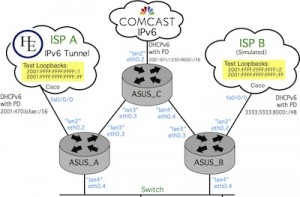 We at NetDEF are proud to announce that the proof-of-concept code for the Homenet with ISIS Autoconf and ISIS SrcDest routing is now available.
We at NetDEF are proud to announce that the proof-of-concept code for the Homenet with ISIS Autoconf and ISIS SrcDest routing is now available.
This is the code which we demo’d at the IETF 90 in Toronto as part of the Bits’n’Bytes.
The code is 4 GIT repositories:
- ISIS source code.
https://git.netdef.org/projects/OSR/repos/isis
If you want to build ISIS code on a generic Linux System (not part of OpenWRT), then use this git. We added detailed build instructions for Ubuntu 14.04LTS and some ISIS command help in the Doc directory in this repo - Complete OpenWRT build root with the Homenet/ISIS code integrated.
https://git.netdef.org/projects/OSR/repos/openwrt-buildroot
If you want to build a OpenWRT system, then use this git.
Also includes some example configs to assist building the OpenWRT on various platforms (Intel, ASUS RT-16N, TP-Link Archer C7 V2). For details and help on getting started see README the build-helpers/ Directory in this git - OpenWRT feed for the Homenet ISIS code.
https://git.netdef.org/projects/OSR/repos/openwrt-isis-hnet
If you want to integrate the Homenet ISIS code into a different OpenWRT buildroot, then use this git which is the isis feed for OpenWRT - Quagga with SrcDest modification.
https://git.netdef.org/projects/OSR/repos/srcdest
The official Quagga doesn’t contain (yet) the required changes for Src-Dest. This should be done soon and we’ll change over our git at that time
The fastest way to get started is to clone the openwrt-buildroot git which includes the complete OpenWRT with Homenet and our ISIS code. There are example build configs with this code for ASUS RT-N16, TP-LINK Archer C7 (V2), Intel KVM (32 & 64bit), and Soekris Net4801 and Net5501
In general, we believe that the current proof-of-concept code should work on all barrier breaker supported OpenWRT systems with 16MB Flash (or more) and a decent amount of RAM. (If less flash is available, then you need to remove some modules – our example config contain a lot of debug tools directly built in)
Please be aware that the code is only a Proof-of-concept and probably has security holes (like the debug ISIS screens on port 8080) and probably lots of bugs.
